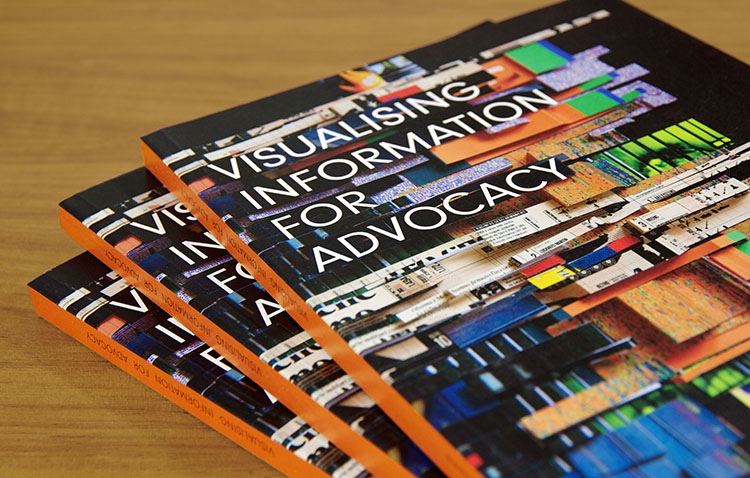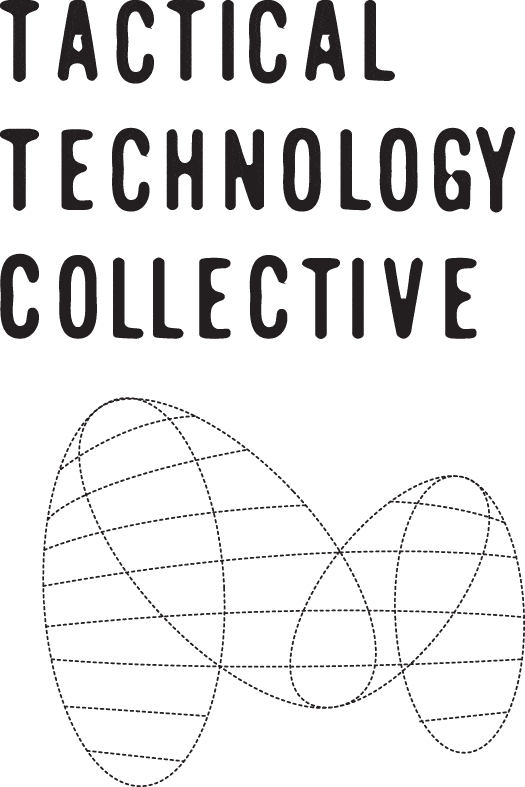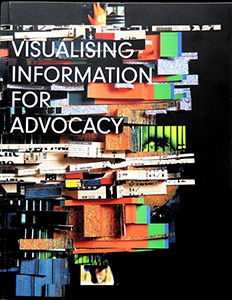Visualising Information for Advocacy is a book about how advocates and activists use visual elements in their campaigns. This 160-page guide features nearly 50 case studies from around the world to provide an introduction to understanding visual information and a framework for using images for influence.
In October 2013, Tactical Tech released the first edition of Visualising Information for Advocacy, and a second edition a year later. Now, in October 2016, the Arabic translation is online. This book is a contextualised translation: the translation took place through a process of review and inputs from colleagues and partners from the Arabic-speaking region; we also wanted the book to be more locally relevant, so it has a new chapter showcasing campaigns and contextualising the politics of the visual in the Arab region. Based on desk research and interviews with activists, journalists, artists and creative practitioners from the Arab region, the new examples in this edition emphasise three functions of the visual in activism: for witnessing; for visual debate and as commentary; and to memorialise and create modes of remembering. The chapter showcases performance art, digital memes, political cartooning, graffiti and murals, digital media, and posters; and features the work of “Antikka”, Ali Ferzat, B'Tselem, Gaber, Lina Attalah, Murad Subay,and Wafaa Bilal, among others. You can download a copy here, or write in to ttc [at] tactticaltech [dot] org with "Arabic VIFA" in the subject line and ask us to post you a copy. We're also looking for local bookstores and NGO partners to stock copies of the book. If you think you could become a dispatch hub, please write to us!
The ideas in Visualising Information for Advocacy have been developed through nearly 50 workshops we have led for activists, journalists and advocates campaigning on issues as diverse as corruption and transparency, pro-democracy, land-grabbing, toxic waste, water scarcity, migration, maternal and child health, forced labour, violence against women, gender and sexuality rights, indigenous people's rights, child rights and anti-torture. These workshops have taken us to many countries to work with activists from Kazakhstan to Kenya.
At Tactical Tech we have been analysing how different kinds of visual techniques serve the work of advocacy, and have been testing out our ideas. We have developed three ways to classify how the visual works in advocacy campaigns:
- Get the idea is about making simple, eye-catching products that convey one concise point, provoking and inviting audiences to find out more about the issue.
- Get the picture is about creating a visual summary of an argument by crafting a narrative with visuals and data.
- Get the detail is about presenting data through interactive digital formats in a way that allows the audience to dig deeper and explore the issue for themselves.

Flick through Visualising Information for Advocacy to get inspiration for your project, try out some of the visual techniques showcased, or find advice on how we produce visuals for advocates. You can read reviews of the book here.
How can I get involved?
Download or buy the book
Download the book as a PDF or buy your own copy here. The Arabic version is available as a PDF for download here.
Write about it!
Write a review and tell us about it either via email or via twitter @seeingsideways or @info_activism.
Translate it!
The book is now available in Arabic; we're working on Spanish and Russian translations. If you would like to translate the book into another language, email us.
Adapt it!
We encourage you to take our work and build off it! If you do so, we are interested to know how it worked out by emailing us.
Watch our official unpacking video "The Arrival"
About the authors
Visualising Information for Advocacy was written and researched by Maya Indira Ganesh, Stephanie Hankey, Tom Longley and Marek Tuszynski, all of whom have been working on the area of data, technology and activism for over a decade.
Maya after leading the 'Evidence & Action' programme for three years, Maya transitions into a new role as the Director of the Applied Research programme. Our current research projects examine digital security pedagogies and practices, and the flip sides of applications of technology for transparency and accountability. Maya's role also includes 'field building', to convey Tactical Tech's work with its peers and partners as critical contributions within the information-advocacy sector. Maya holds Masters degrees in Applied Psychology from Delhi University, and in Media and Cultural Studies from the University of Sussex.
Stephanie has worked worldwide to bring art, design and technology together with activism and campaigning for twenty years. She started trying to combine these ideas whilst studying History of Art and Design in 1994 and then in her Masters in Information and Interaction design at the Royal College of Art, London. She then worked to develop and support early digital campaigning until she co-founded Tactical Tech in 2003. As a practitioner, she has worked for the last decade to train activists worldwide on effective digital activism, using a combination of technology, networks, design and campaigning skills. In 2011, she co-founded our creative design agency for advocacy, Tactical Studios. In 2013 she was awarded an Ashoka fellowship for her work as a social entrepreneur.
Tom is an independent human rights and technology specialist who helps activists use data and technology safely and effectively. Coming from a legal background he has investigated war crimes and large scale human rights abuses in Kosovo, Sierra Leone, Zimbabwe and others. He has recently researched a report for Global Witness on the dramatic rise in killings of land and environmental defenders.
Marek makes different things: he can write, talk and draw. He likes basic and complicated ideas. He is also good at listening to other people and politely turning their thoughts into his own. He can also produce things: books, films, events and shapeless objects. He is never bored. You can read his recent stuff here; watch here or listen to here. And more importantly he also like to inspire other people to do things and stay politically tuned in that's why he co-founded Tactical Technology Collective a good 12 years ago.
We are indebted to our vast global network of friends, supporters and collaborators for giving us the opportunity to learn from them and it is to them that this work is dedicated. We extend our heartfelt thanks to all of the people how have helped us with this book and to our colleagues at Tactical Technology Collective who have helped us with the writing, editing, designing, reviewing and promoting of this book. The research, testing, development, writing and production of this book was made possible thanks to the support of Open Society Foundations with additional support from Hivos, Oak Foundation and the Sigrid Rausing Trust.
What are we working on now?
We are now working on our next projects exploring how advocates are using and communicating increasingly complex and growing amounts of data for advocacy so keep an eye on our blog and our newest project Exposing the Invisible.
We're also working on translating Visualising Information for Advocacy so please contact us at visualisingadvocacy AT tacticaltech DOT org for guidance and support if you would like to translate parts or the whole of this publication.
Still want to know more about us?
You can get in touch or see our other work by going on our website, sending us an email, tweet or facebook message. We also have a monthly newsletter where you can catch up on what we've been up to at Tactical Tech, find out about launches and events, and look through some of the more interesting things we've found on the internet this month.






